
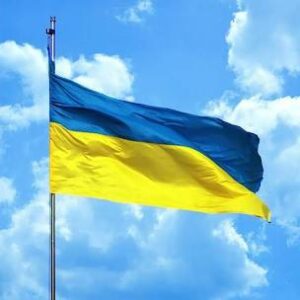
Pray for the suffering people of Ukraine, Gaza and the West Bank.
Before we begin: Two other notable saints come up next week.
July 20: The Holy Prophet Elijah (Elias)
July 22: Saint Mary Magdalene
At the bottom of this Post, if you’d like, you can access the articles I wrote about them some years ago. The stories haven’t changed. The illustrations have.
Two Very Different Martyrs
Elisabeth was a Grand Duchess, European royalty. Alexander was a “commoner”, to use the old-fashioned term.
Elisabeth was from Germany but was martyred in Russia, while Alexander was from Russia but was martyred in Germany.
Elisabeth was a Lutheran who converted to Orthodoxy. Alexander was raised Orthodox.
Elisabeth was martyred because she was royalty. Alexander was martyred because of his anti-Nazi activities.
Elisabeth was martyred by “left-wing” Bolshevik Communists. Alexander was martyred by “right-wing” Nazi fascists.
Though actually that made them similar. Not to get sidetracked into political theory here, but politics is not like a bird with wings. Politics is more like a circle. Far “left” and far “right” meet at the top (or rather it’s the bottom) and are virtually identical in practice. Something worth noting today.
Here’s what chiefly united Elisabeth and Alexander: Both were devout members of the Orthodox Church. Both had a strong social conscience. Both were martyred.
The Holy Martyr Elisabeth, Grand Duchess of Russia
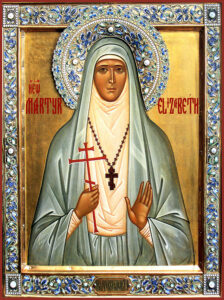
Commemorated on July 18
Elisabeth of Hesse-Darmstadt was born on November 1, 1864. She was baptized in the German Lutheran Church, named after Elisabeth of Hungary (1207-1231), a Roman Catholic saint from her own family. Her mother died when she was a child, and she went to England to live under the protection of her grandmother, Queen Victoria * – so if her childhood faith was Lutheran, a fair amount of her adolescence was Anglican.
- The royal houses of Europe were inter-married and intermingled. World War I was fought among cousins: King George V of Britain, Kaiser Wilhelm II of Germany and Tsar Nicholas II of Russia! and it destroyed the thrones of two out of the three. The war was fought for no good reason and accomplished nothing, except that about 16.5 million people died.

Elisabeth was considered one of the great beauties of European royalty, “quite a catch”, but she refused several acceptable offers of marriage. Then in 1884, very contrary to her grandmother’s preference, Elisabeth married Grand Duke Sergei Alexandrovich, the fifth son of Tsar Alexander II of Russia.
After several years, as Metropolitan Anastassy wrote, “The Grand Duchess, of her own volition, decided to unite herself to the Orthodox Church. When she made the announcement to her spouse, according to the account of one of the servants, tears involuntarily poured from his eyes. The Emperor Alexander III himself was deeply touched by her decision. Her husband blessed her after Holy Chrismation with a precious icon of the ‘Savior, Not Made by Hands’ (a copy of the miraculous icon in the Chapel of the Savior), which she treasured greatly throughout the remaining course of her life. Having been joined to the Faith in this manner, and thereby to all that makes up the soul of a Russian, the grand duchess could now with every right say to her spouse in the words of the Moabite Ruth, ‘Your people have become my people, and your God my God.'” Ruth 1:16.
Elisabeth wrote to her Lutheran and Anglican relatives “back home” that it pained her to cause them grief, but she was “intensely happy”; “I am sure God’s blessing will accompany my act which I do with such fervent belief, with the feeling that I may become a better Christian and be one step nearer to God.” They must have questioned her motivation, for she wrote, again: “You tell me that the outer brilliance of the church charmed me… in that you are mistaken — nothing in the outer signs attracted me — no — the service, the outer signs are only to remind us of the inner things.”
Life in feudal Russia was changing. The industrial revolution had taken hold. The Tsars had always ruled absolutely, and their response now was not to adjust to the times, but to repress, sometimes by force. There were riots and talk of revolution. On February 18, 1905, her husband the Grand Duke Sergei was assassinated.
In reaction Elisabeth did two things:
1 She visited her husband’s assassin in prison and forgave him. He did not recognize her at first, and asked “Who are you?” “I am his widow,” she replied. “I did not want to kill you,” he said. “You did not understand that by killing him you were killing me,” she said. She gave him a copy of the Gospel and begged him to read it and repent before God. Leaving the prison, the Grand Duchess said: “My attempt was unsuccessful, but, who knows? perhaps at the last minute before he is executed he will understand his sin and repent.”
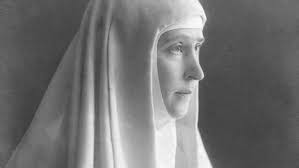
2 She sold her most luxurious possessions and with the proceeds opened the Martha and Mary home in Moscow, to foster prayer and to help devout women to assist the needy. Elisabeth had seen that the poverty of the Russian masses far exceeded anything she had observed in the West. In April 1909 Elisabeth and seventeen women formed a women’s monastery, set aside as Sisters of Love and Mercy. Their work flourished: soon they opened a hospital and other charitable endeavors. It was not to endure.
In March 1917 came the Bolshevik Revolution. The Tsarist state, now fatally weakened by their policies at home and by the war with Germany, fell to the Bolshevik Communists. Civil war followed: the “Red Russians” against the “White Russians”. The Red Bolshevik Russians were militantly atheistic, seeing the Church as a pillar of the Tsarist regime, as indeed it was. The White Russians were divided: some were democratic, others still supported the Tsar.

The Bolsheviks won. They persecuted the Church with dreadful force. Hundreds of priests and nuns were imprisoned, taken away to distant labor camps, many executed. Churches were destroyed. It was said that at one point only three Orthodox bishops were left functioning in Russia, and two of them were probably Communist dupes.
On May 17, 1918, Elisabeth was arrested with two sisters from her monastery, and transported across country to Perm, then to Ekatarinburg, and finally to Alapaevsk, far to the east. On July 17 the Tsar and his family were executed by firing squad. During the following night Elisabeth, a sister Varvara from their Monastery who refused to abandon her, and remaining members of the royal family were thrown down an abandoned mineshaft. Elisabeth’s last words were: “Lord, forgive them, for they know not what they do.” For a while the murderers heard music from the mineshaft: the singing of the Cherubic Hymn. So they dropped a grenade down the shaft. The singing continued. Another grenade. The singing continued. So they covered the top of the shaft with chaff from a nearby field and set it afire, plugging the oxygen and the noise.
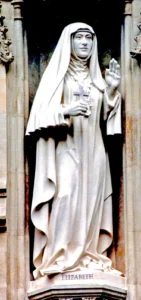
Later the White Army briefly recaptured the area, and Saint Elisabeth’s relics were recovered, and the account of a person who witnessed it was recorded. Her relics were first taken by the White Army to Beijing for safety and placed in the Church of Saint Seraphim of Sarov, and then they were transferred to Jerusalem and placed in the Church of Saint Mary Magdalene, which she and her husband had helped to build.
Her principal shrine in Russia is the Saints Mary and Martha Convent which she founded in Moscow.
The Holy Martyr the Grand Duchess Elisabeth was formally recognized as a saint by the Russian Orthodox Church Abroad in 1981, then by the Moscow Patriarchate in 1992, and so by the Holy Orthodox Church throughout the world.
She is also on the calendar of the Church of England and is one of ten 20th-century martyrs from around the world depicted in statues above the Great West Door of Westminster Abbey in London.
The Holy Martyr Alexander of Munich
![]()
Commemorated on July 13
Alexander Schmorell was born in Orenburg, Russia on September 16, 1917. His mother died when he was only one year old. His father, who was of German origin and was Lutheran, hired an Orthodox nanny, who took the little boy to Liturgy and taught him the customs that little children are drawn to. His father allowed him to be baptized in the Russian Orthodox Church. In 1921 Alexander’s family fled Russia, to escape both anti-German sentiment following the war and also from the Bolsheviks. They moved to Munich, Germany, since Alexander’s father still held German citizenship. His father remarried another Russian woman.
An anecdote from when Alexander was a boy: In Bavaria, religion classes were compulsory – either Catholic or Protestant. Alexander was placed in the Catholic class. One teacher criticized him for making the sign of the Cross “backwards”. He refused to change.

Alexander planned to study medicine, like his father, and began his formal studies in 1939 in Hamburg. This was immediately interrupted by the beginning of World War II. He was quickly called into military service where he served as a medic, despite the fact that he refused to swear the Hitler Oath, a pledge of personal allegiance to Adolf Hitler * that was normally required of all soldiers.
- Authoritarian leaders seek loyalty to themselves, personally.
He served in Russia. * Now Alexander for the first time made contact with the Orthodox Church “in her glory”. (Repression had ended. Stalin cynically saw he needed the support of “Holy Mother Russia” during wartime.) He made contact with Orthodox clergy and attended Divine Liturgy – in his Nazi uniform! By 1940 he returned home, committed to the Church, and continued to attended Divine Liturgy regularly.
- The Soviet Union and Germany at the time had a peace treaty – till in 1941 Hitler broke the treaty and invaded Russia.
Alexander now saw Hitler’s Germany with a new perspective. He met a man named Hans Scholl with whom he would create the Nazi-resistance group called “White Rose”, so named to symbolize purity and resistance to the darkness of the evils of the Third Reich.
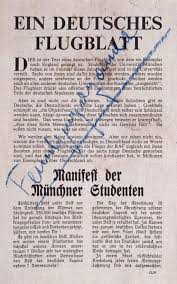
They accomplished this by printing leaflets anonymously under the auspices of “White Rose”, urging people to resist. Others joined them. Alexander and Hans penned the first four of the leaflets which were at first distributed locally and then more widely in Germany. The leaflets appealed to Christian morality and German heritage to denounce Hitler and the Nazi regime.
By 1942, two more people had joined the White Rose group, and they prepared to publish the fifth leaflet. But then, in January 1943, Hans Scholl and his sister Sophie were caught distributing the leaflets at the University in Munich. They were arrested and executed by guillotine on February 22.
With the help of friends, Alexander tried escaping to Switzerland with a forged passport, but the way was too difficult, and he turned back to Munich. On February 24, 1943, he was arrested when someone recognized him in an air-raid shelter.
His pastor was allowed to visit him at Stadelheim prison to administer Holy Communion shortly before he and two of his compatriots were executed (by guillotine) on July 13, 1943. He was 25 years old.
White Rose was not formally a religious group, but there is no doubt that faith in God was one of the primary reasons that these young people acted with the bravery they did. Alexander Schmorell was the only one of the group who was Orthodox. His friend Lilo Ramdohr said he was somebody who always had a Bible with him and claimed his lifelong love of Orthodoxy. In his letters to his family from prison, he wrote about the deepening of his faith. “Now it shall be none other than this, and by the will of God, today I shall have my earthly life come to a close in order to go into another, which will never end and in which all of us will again meet. Let this future meeting be your comfort and your hope. Unfortunately, this blow will be harder for you than for me, because I go in the certainty, that in my deep conviction, I have served the truth…” His last letter concluded: “Never forget God!!”
As he walked to his death, he said to his lawyer, “I’m convinced that my life has to end now, early as it may seem, for I have fulfilled my life’s mission. I wouldn’t know what else I have to do on this earth.
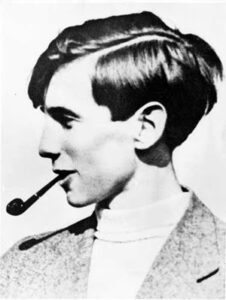
Alexander Schmorell was buried behind Stadelheim Prison, in the cemetery at Perlacher Forest.
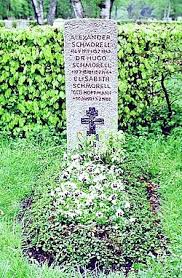
His parish church had looked long for a permanent location, with no success. Then a church building came up for sale directly across from Alexander’s grave. This they attributed to the intercession of Saint Alexander.
His sainthood was formally recognized by the Russian Orthodox Church Outside Russia on February 5, 2012, and thereby by Orthodox Churches throughout the world.
Here is how his witness is summed up in the publication of our American college organization, the Orthodox Christian Fellowship:
“During his life, St. Alexander faced the hardships of war and oppression, and was challenged to face injustices that morally conflicted with his faith. Although he was enlisted as a part of the Nazi ranks, he continued to prioritize his Orthodox Christian life, and ultimately was led to take a public stance against the teachings of Adolf Hitler through the White Rose. We can pray to St. Alexander to help us in times of peril, persecution, and injustice, especially when our faith in Christ puts us in conflict with the powers of the world.
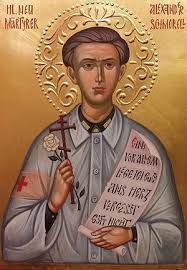
Learn his troparion:
Tone 4
“Today a light adorns our glorious city, having within it your holy relics, O Holy Martyr Alexander; for which sake pray to Christ God that He deliver us from all tribulations, for gathered together in love we celebrate your radiant memory, imitating your bravery, standing against the godless powers and enemies.”
Pray to him!
“Saint Alexander, you followed your Spirit-inspired conscience to resist the injustice of the world. Pray also for us that we might find the courage to remain faithful to Christ in every circumstance and condition. And by your prayers, may we never forget God. Amen.”
Next Week: ……Forgive me…. That story makes me start to cry…. Next Week…. Finally The Conclusion of my First Trip to Greece: Saint Nicholas takes charge.
Week after Next: Why the current “Surge” of Young People into the Orthodox Church?
Sources of information for the Post above:
www.johnsanidopoulos.com/
Orthodox Christian Fellowship: ocf.net
Orthodox Wiki
Orthodox Church in America
If you took their memory seriously, you would encourage your readers to pray for Israel and our Jewish elder brothers and sisters around the world, in midst of rising antisemitism and hatred, partly also inspired by antisemites who are, even still in the 21st century, declared saints by the Orthodox Church bureaucracy, and “canon law” never purged, with content that shockingly resembles the Nazis’ race laws.
St. Elisabeth was grieved by her husband’s expulsion of Jews from Moscow.
Would she adorn a blog post with a flag of those who want the expulsion of Jews from Israel?
St. Alexander was grieved by the persecution and murder of Jews by Nazi-Terrorists.
Would he adorn a blog post with a flag of those who cheer and applaud the persecution, torture, rape, murder of Jews by Hamas-terrorists?
Manfred, you’re back! I hope you have been well.
I agree that anti-Semitism is wrong, always totally and completely wicked. It should be suppressed whenever it appears.
However, being pro-Palestinian is not the same as being anti-Semitic. I am pro-Palestinian, by which I mean I believe the Palestinians have a right to their own homeland – the two-state solution, which the US government once supported and which the Israeli government has now abandoned. I think it’s the only solution to the present mess.
Yes, Hamas is terrorist and even worse stupid. However times have changed. Now Israel is the great Middle Eastern power, and they need to act like it, lest they make things worse. Throwing stones and sending rockets is not to be compared with what the Israeli government is doing to the people of Gaza which is not only a war crime but also stupid: I think it’s only going to produce more terrorists, and here they go again. It’s also causing/justifying the growth of anti-Semitism.
You might (or might not!) want to read my two old Posts about Judaism, in which I argue for some understanding all around. (Good luck to us all.) The comments also are interesting.
https://frbillsorthodoxblog.com/2017/12/01/41-orthodoxy-faiths-judaism-part-one/
https://frbillsorthodoxblog.com/2017/12/08/42-orthodoxy-faiths-judaism-part-two/
You write:
« I think it’s only going to produce more terrorists, and here they go again. It’s also causing/justifying the growth of anti-Semitism. »
1. The fire bombing of German and Japanese cities in WWII did not produce any post-WWII terrorists.
2. Israel’s fighting against the threat of further terrorist attacks certainly does not justify anti-Semitism, and it also does not cause it; in the evening of October 7th, certain people were distributing sweets on the streets of Berlin to celebrate — that was before Israel launched attacks on Gaza.
This is from a decade ago:
https://rabbisacks.org/videos/mutating-virus-understanding-antisemitism/
I repeat: Anti-Semitism is evil. It is in no way justified and should not be tolerated.
As for the rest, you may be right. I may be wrong. Or vice versa. Only time will tell.
Except: There is nothing that in any way can possibly justify Israel doing this, nor is there anything in any way that can possibly justify the rest of the world tolerating this slow intentional starvation of innocent Gaza civilians:
https://www.nytimes.com/2025/07/24/world/middleeast/gaza-starvation.html
That’s all I’m going to say on this subject.
Father Bill
I once read the pamphlets written by Alexander Schmorell and Hans Scholl (have you?); very evidently highly intelligent, well-educated young men, not taken in by propaganda.
They certainly would have easily spotted the « intentional » in your:
« There is nothing that in any way can possibly justify Israel doing this, nor is there anything in any way that can possibly justify the rest of the world tolerating this slow intentional starvation of innocent Gaza civilians: »
Re: New York Times
https://www.thefp.com/p/mistakes-at-the-new-york-times-only
I read the “New York Times” twenty or thirty years ago for a while, via the “International Herald Tribune”, which it ran jointly in those days with the “Washington Post” — being from West-Germany, one was being raised to hold the default position that things from the US are good.
I was totally surprised how bad the journalism presented there was (even back then), particularly regarding anything touching the area of cultural life. Verbosity coupled with shallowness.